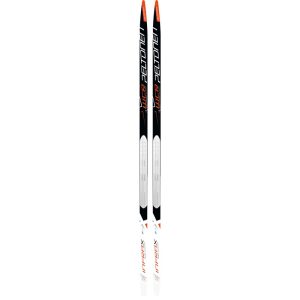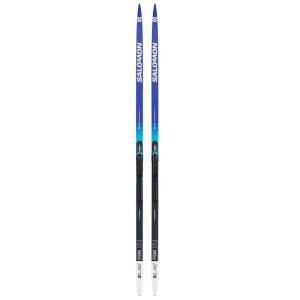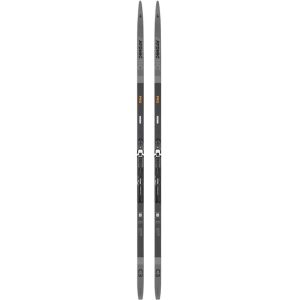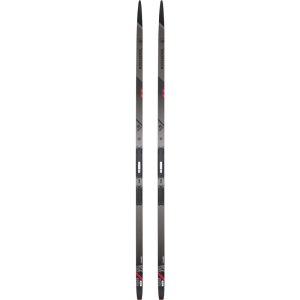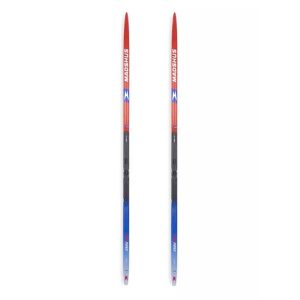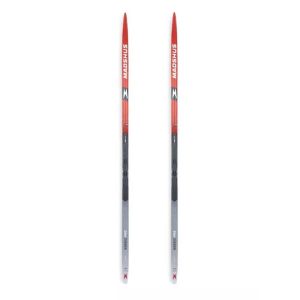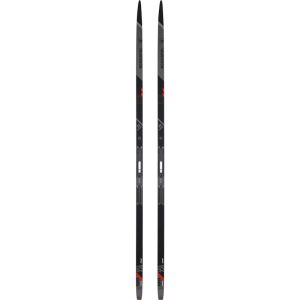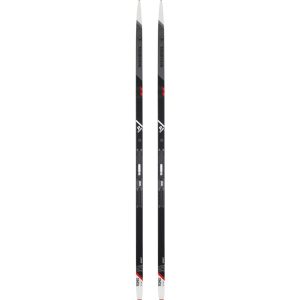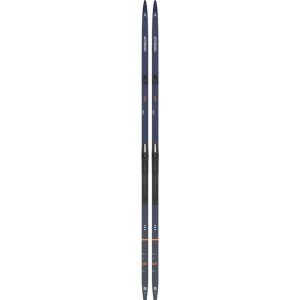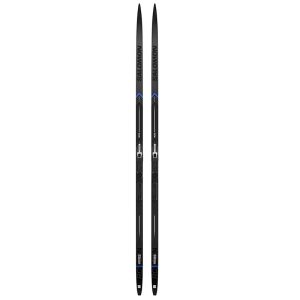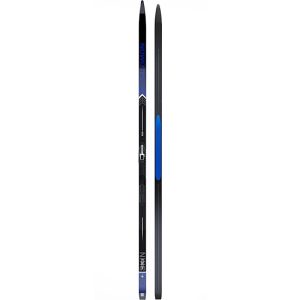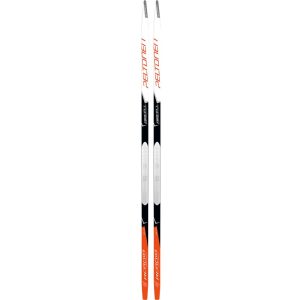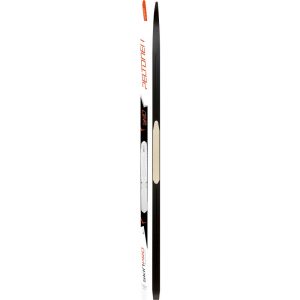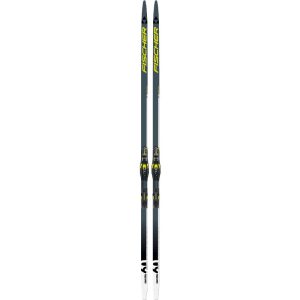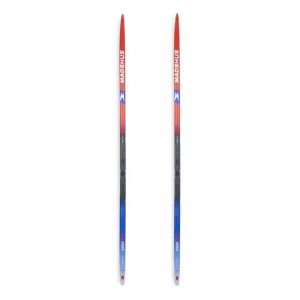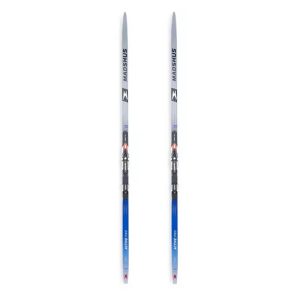The new crop of classic skis for 2024 include a wide selection of both high-performance and value-oriented skin skis, and even a few waxable models.
Peltonen Infra X
$850 | peltonenski.fi | 1,180g/pair (195) | sidecut: 44/44/44

As part of its reintroduction to U.S. distribution, Finnish brand Peltonen offers this top-of-the-line waxable race ski, and in a world of skin skis, testers embraced the option. “Oh, boy, this ski was fun,” enthused one. No wonder: it gallops on downhills and gobbles up climbs with ease. Like its skate sibling, the Infra X derives its lightness from a Nomex honeycomb core surrounded by carbon laminates. A high ski profile allows more space for the kickwax pocket and less drag while gliding. Noted one tester, “Very responsive to activating the wax pocket as well as the glide.” Also enhancing glide is a new fluor-free nano base material. “The best ski of the test,” raved a fan. Available in two flexes and universal and cold profiles.
Where to buy
Salomon S/Lab Carbon eSkin
$900 (includes Shift Race bindings) | salomon.com | 1,000g/pair (201) | sidecut: 44/44/44

Salomon calls this new-for-last-winter model the lightest skin ski it’s ever made, and we were finally able to run it through its paces. It easily won over testers with its excellent kick, great balance of grip to glide and precise cornering and maneuvering. This second-generation of the top-of-the-line skin model benefits from a World Cup grind and the G5% base, engineered to glide up to 5 percent faster, depending on temperatures. Additionally, a universal skin size across all four ski lengths means glide isn’t compromised on longer skis, and a particularly springy camber drives acceleration as the skier transitions to gliding. “Almost as smooth as a well-waxed classic ski,” said one tester. Added another, “Would make an excellent training ski for elite racers.”
Where to buy
Atomic Pro C3 Skintec W
$430 (includes Prolink Shift bindings) | atomic.com | 1,390g/pair (195) | sidecut: 43/44/44

Last year we tested the unisex Pro C3 Skintec; this year, a new women’s-specific model joins the line. Both versions now have a slightly lower binding stack height for better ski feel. Though the Pro C3s are targeted at beginners and intermediates, testers lauded this ski for being a noticeable step up in performance. Said one, “It’s a little lighter, with a little better glide,” than the typical entry-level ski. The C3 scored high among all testers for stability and received praise for both its cornering ability and climbing prowess (“even on an icy hill,” per one comment). The construction and sidecut of the women’s version is identical to the unisex ski; however, the women’s version not only comes in shorter lengths but in more flex options.
Where to buy
Rossignol Delta Course R-Skin
$450 | rossignol.com | 1,120g/pair (198) | sidecut: 44/44/44

This new mid-price-point ski takes its place at the top of the performance-oriented Delta series. Similar to its new skate ski sibling, the Course is built around a Nomex honeycomb core that extends along the center two-thirds of the ski, along with air-channeled paulownia in the tips and tails. What’s evident from the test: the Course punches above its weight class. In particular, most testers loved how well the ski glides (“kept me sailing even up climbs,” “probably best of all the skin skis”). It’s no slouch on climbs, either; “great grip in glazed south-facing tracks at mid-day,” reported a tester. For advanced to even expert skiers looking for excellent performance at a relatively wallet-friendly price, the Course is right on the money.
Where to buy
Madshus Endurace Skin
$376 | madshus.com | 1,094g/pair (187) | sidecut: 43/44/44

A step below Madshus’s top-tier Redline race skis, the Endurace Skin has the brand’s proprietary AstaraLite foam core, combined with the same type of progressively placed skin as described in the Nordic Pro Skin review in this section. Together, these features help produce a ski that impressed reviewers as particularly stable and smooth; so smooth, in fact, that it could almost pass for a waxable classic ski. One tester wrote, the Endurace is “well balanced, with excellent flow from kick to glide.” Just don’t equate that efficiency with a lack of personality. The Endurace is fun and lively with a knack for climbing—“the best of all the classic skis I tried,” per one tester. In sum, “a great ski for someone moving up from fitness skiing to citizen racing.”
Where to buy
Madshus Nordic Pro Skin
$335 | madshus.com | 1,175g/pair (187) | sidecut: 47/44/46

A wider tip and tail for added stability and easier turn initiation distinguish the Nordic Pro Skin from Madshus’s other classic skis. It also has what the brand calls a progressive milling profile—at each end, the skin is set slightly deeper within the ski base (to aid glide) and shallower, or closer to the snow, in the middle (for more grip), reflecting the wax pattern on a traditional classic base. All of that can be summed up in three words: easy to ski. With characteristic Madshus smoothness, the Nordic Pro hoovered up any bump it encountered, related one tester. All reviewers pointed out the ski’s rock-solid stability. For recreational skiers and those who like to tour long, this ski more than delivers.
Where to buy
Kästle XA10 Classic Skin
$279 | kaestle.com | 1,430g/pair (193) | sidecut: 42/45/44

This new model is one of the least expensive classic skis Kästle offers, and its forgiving flex is aimed squarely at fitness skiers and those working on their technique. For that audience, testers said, the XA10 hits its mark. Beginners will find a ski that won’t charge out of the gate and leave them (on their) behind. Instead, this one is easy turning and stable in and out of the track, if a bit on the sluggish side. “A good knock-around ski,” commented one reviewer. Said another, “Very stable. I could climb up a wall with these.” Cautioned a long-time instructor, who found the XA10’s sizing off compared to the length he usually skis, “If not sized correctly, the ski may not live up to its potential.”
Kästle XA20 Classic Skin
$219 | kaestle.com | 1,470g/pair (190) | sidecut: 60/50/55

Another new model, the XA20 has a noticeably wide tip and tail, intended to give users the freedom to forge their own trail, though it easily works in a track, too. “Very stable—a good beginner ski,” shared one tester. “Almost metal-edge stability without the metal edge,” said another. Reviewers liked the XA20’s responsiveness during the kick phase, though most commenters felt the ski prioritizes grip over glide. For those learning to build up confidence while going downhill, that inherent braking could be helpful. Nonetheless, some testers found that moving the adjustable binding back from neutral effectively increased the ski’s glide. Despite its literal sticking points, the XA20 can be a good go-anywhere ski for those new to the sport.
Kästle XP20 Classic Skin
$559 | kaestle.com | 1,100g/pair (196) | sidecut: 41/44/44

Kästle bills this ski as delivering race performance in a recreational model, but testers found it doesn’t quite live up to that promise. A honeycomb paulownia core shaves off weight compared to the other Kästle skin skis we tested, and a new tip profile debuted this winter. Reviewers reported the ski has decent glide, but that it comes at the expense of reliable grip. The XP20 scored well for stability (“even on icy snow,” pointed out one tester), and skiers highlighted the ski’s good control on downhills, as well as while cornering. Intermediates who like to put in miles on the flats or on gently rolling terrain and want a lightweight ski to keep them fresh will be happiest on this Kästle model.
Rossignol Delta Comp R-Skin
$350 | rossignol.com | 1,160g/pair (198) | sidecut: 44/44/44

One step down from the Delta Course, this ski resembles its sibling in construction, but the wood used in the air-channel tip and tail is a slightly heavier poplar, for an overall weight difference that testers did discern. Rossignol revamped the ski’s camber this season for longer glide, though a couple of reviewers found the ski a little draggy. Overall, it’s a solid performer, receiving good marks for stability and ability to climb. “Kicks well in a variety of conditions, from fresh and windblown to glazed tracks,” one tester said. Compared to its more vivacious sibling, however, the Comp fell a bit short. “Still fun but not quite as lively as the Course,” another commented. So the question is, what’s $100 worth to you?
Where to buy
Rossignol Delta Sport R-Skin
$250 | rossignol.com | 1,110g/pair (196) | sidecut: 44/44/44

Like the Delta Comp, this ski received a camber makeover for a longer glide phase. Unlike the other Deltas, it’s made with a carbon honeycomb core and, surprisingly for a lower-price-point ski, weighs in as the lightest model of the series. As the entry-level Delta ski, however, the Sport also has a more limited size run than its higher-end siblings. Our testers deemed the ski a capable and approachable performer for casual recreational skiers and even junior racers. Sure, it doesn’t have the bells and whistles of a top-of-the-line race model, but it incorporates characteristics of higher-performing options (e.g., a lightweight core with air-channel wood at tip and tail) for a value-oriented price. That’s trickle-down technology at its best.
Where to buy
Atomic Pro C2 Skintec/Pro C2 Skintec W
$330 (includes Prolink Shift bindings) | atomic.com | 1,390g/pair (195) | sidecut: 43/44/44

The unisex Pro C2 remains largely unchanged for this year, though like the C3, it, too, benefits from a lower binding stack height that aims to enhance ski feel. There were more developments on the women’s side: that version of the ski comes in a new 174 length, as well as in additional flexes in the shortest lengths. Testers found the ski user friendly and very maneuverable. A few commented that it felt heavy; unlike the C3, this ski doesn’t have any carbon in the core. The C2 scored particularly high for its climbing ability; “has amazing kick and glide balance on the uphills,” enthused one reviewer. “Well-suited for an intermediate skier looking for an easy ski to use,” summed up a tester.
Where to buy
Salomon RC10 eSkin
$500 (includes Shift binding) | salomon.com | 1,300g/pair (201) | sidecut: 44/44/44

What sets this brand-new ski apart? Something you can’t see. Salomon’s Stringer Core technology uses polyurethane (PU) in a symmetrical reverse-fishbone pattern, which adds lots of air channels. Salomon says the resulting core is 22 percent lighter than one made of traditional PU and uses 22 percent less material. So how did the RC10 ski? Testers commented more on performance than weight but liked the overall feel. “Playful and handled all terrain with ease,” wrote a tester. Others noted that the ski’s glide was smooth and fast; “better glide than other skin skis in its class,” stated one reviewer. For sporty recreational skiers more apt to rack up miles than start lines, this is one to consider. The ski comes in four flex profiles and a women’s version.
Where to buy
Salomon RC8 eSkin
$360 (includes Shift binding) | salomon.com | 1,400g/pair (201) | sidecut: 44/44/44

Also new, the RC8 incorporates the same String Core tech as the RC10 but weighs in a bit heavier. That’s due to a different base material (and, perhaps, because this ski is produced in another factory). In many ways, the ski performed similarly to the RC10, observed most testers, although they were aware of the additional grams. “Easy to edge and turn, and stable at higher speeds,” said one. A couple of testers noted issues with grip that they managed to work around. “Steeper hills needed the correct body position,” wrote an instructor, while another skier observed that the adjustable Shift bindings were “critical” in dialing in the kick and glide. A new RC7 eSkin, one level below this ski, rounds out the family.
Where to buy
Peltonen Acadia Classic
$425 | peltonenski.fi | 1,200g/pair (195) | sidecut: 44/44/44

The classic counterpart to its skate sibling of the same name, this ski best suits those training for long-distance events like a Loppet and recreational kick-and-gliders who prefer a waxable ski. It’s also a great choice for someone who’s not ready for the Formula One character of Peltonen’s Infra X. Along with feeling smooth and stable, the Acadia’s got some pep, immediately responding to the amount of kick and glide you put into it. “Very lively and responsive. I’d recommend this to anyone looking to get into waxable classics,” wrote a tester. A reviewer who hadn’t tried a waxable classic ski before found the Acadia light and approachable. It comes in medium and stiff flexes to accommodate a range of skier weights.
Where to buy
Peltonen SkinPro
$530 | peltonenski.fi | 1,350g/pair (195) | sidecut: 44/44/44

For a mid-tier model, this ski out-performs its category. Testers loved the butter-smooth, stable feel and found it very responsive during the kick phase. “Excellent stability,” commented a tester, with another terming the SkinPro “a lively ski with excellent glide.” Compared to Peltonen’s other skin skis, the skin here is slightly longer and lower and has more traction, making the ski more forgiving for recreational skiers. One reviewer, who liked the ski even though the test lengths were below his weight range quipped, “I wish it were here in fat-guy flex.” In fact, Peltonen offers each length of its skis in multiple flexes—in this case, six different ones. So skiers of all shapes and sizes can find their bliss on this ski.
Where to buy
NEW BUT NOT TESTED
Atomic Pro Ultralite Skintec
$400 (includes Prolink Shift bindings) | atomic.com | 1,390g/pair (196) | sidecut: 45/44/47

With similar construction to Atomic’s Pro C3 Skintec but a wider tip and tail, this ski is targeted toward beginner to intermediate skiers who desire a little more stability as they kick and glide.
Madshus Active Pro Skin
$404 (with Rottefella Performance bindings) madshus.com | 1,148g/pair (187) |sidecut: 43-44-44

One notch below Madshus’s Endurace Skin, this ski also has a skin that’s deeper at the ends and shallower in the middle, mimicking the way you’d wax a traditional classic base.
Where to buy
*Affiliate link disclaimer:
At Cross Country Skier, we are committed to providing you with honest and informative gear coverage. To support our work and continue delivering quality content, we are including affiliate links in our reviews. Partnerships with retailers are separate from coverage, ensuring that our reviews remain unbiased. These links help us earn a small commission if you make a purchase through them, at no additional cost to you.

